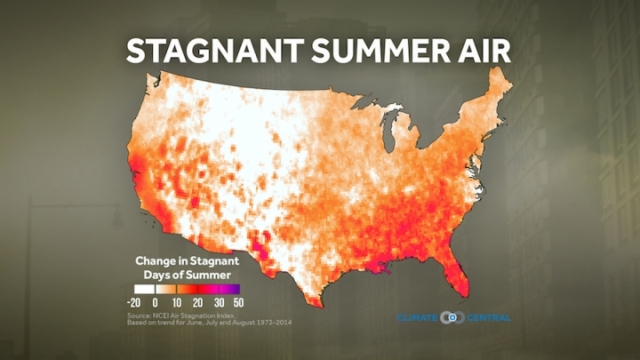Those long, hot, sultry days of summer, the ones where the air seems so still it wouldn’t disturb a leaf, are also days where air quality can take a nosedive. With winds barely above a whisper and atmosphere-scouring rains nowhere in sight, pollutants can build up in the air we breathe, with potentially serious health consequences.
Since climate change is expected to usher in more oppressive heat waves, the number of days with stagnant air will likely go up, which could mean more days with bad air quality, if nothing is done to combat pollution. A recent Climate Central analysis suggests they already have.
Days with less than stellar air quality can of course happen at any time of year. They’re a regular occurrence during winter in Salt Lake City, where so-called inversions (featuring a layer of cold air trapped below a warm layer) allow pollutants to build up in the valley where the city sits.
But summer is when days with stagnant air are most likely to happen around most of the country, as areas of intense high pressure in the atmosphere can park over a region for days at a time, keeping away the winds and rains that could give the air a good cleaning.
When such events happen, it can mean that ozone and other harmful pollutants emitted by cars and industry can accumulate, irritating lungs and throats even in healthy people, but particularly causing issues for those with lung conditions like asthma.
Climate Central looked at how the number of summer “stagnation days” for cities across the U.S. had changed since 1973 using the National Centers for Environmental Information’s Air Stagnation Index. The ASI uses a combination of upper air wind, surface wind and precipitation data to determine days when conditions are ripe for pollutants to build up in the air.
The analysis found that stagnation days had increased across much of the country, most noticeably in the Southwest and Southeast. For example, in San Francisco there are on average 23 more stagnant air days each summer now than there were 40 years ago, while in New Orleans there are 28. See how your city has fared in the interactive graphic below.
Separately, a group of researchers has looked at how those trends might change by the end of this century with additional warming.
In one study, published in 2012, they looked at how the number of stagnation days (following the ASI) would change assuming the world adopted a mix of fossil fuel and renewable energy sources, while the follow-up study, published in 2014, looked at the same question assuming fossil fuel emissions continued on the same path they’re on now.
They found the largest U.S. increases in the eastern portion of the country, but with some other hotspots in the central and western regions. The changes were around six to nine more stagnation days compared to the late 20th century, but the reasons behind the changes varied between regions.
In the West, increases came from having more days without precipitation to scour the air, while in the Southeast it was due to weak winds that would keep pollutants from being dispersed.
Of course, this doesn’t guarantee worse air quality in the future, as steps can be taken (as they have been in recent decades) to reduce the amount of pollutants getting into the air in the first place, as well as to combat the greenhouse gas emissions that lead to warming.
via Stagnant Summer Days on the Rise in U.S. | Climate Central.





















